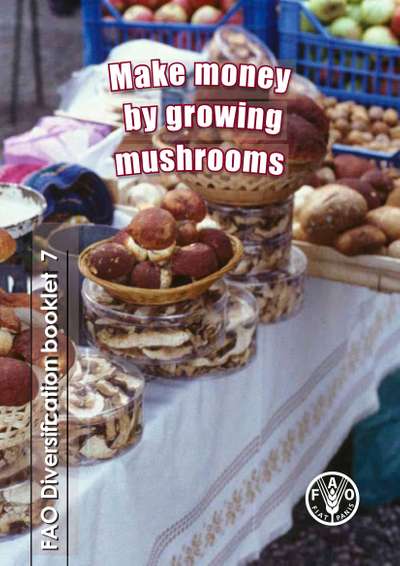23 Issues in this Publication (Showing 21 - 23) Previous
Make Money by Growing Mushrooms - 2009/01/20
There are hundreds of identified species of fungi which, since time immemorial, have made a significant global contribution to human food and medicine. Some estimate that the total number of useful fungi – defined as having edible and medicinal value – are over 2 300 species. Although this contribution has historically been made through the collection of wild edible fungi, there is a growing interest in cultivation to supplement, or replace, wild harvest. This is a result of the increased recognition of the nutritional value of many species, coupled with the realization of the income generating potential of fungi through trade. In addition, where knowledge about wild fungi is not passed on within families or throughout communities, people have become more reluctant to wild harvest and prefer to cultivate mushrooms instead.
Mushroom cultivation can help reduce vulnerability to poverty and strengthens livelihoods through the generation of a fast yielding and nutritious source of food and a reliable source of income. Since it does not require access to land, mushroom cultivation is a viable and attractive activity for both rural farmers and peri-urban dwellers.
Frost Protection: Fundamentals, Practice and Economics - Volume 1 - 2005/01/20
- Also available in:
- Español (es)
- English (en)
The book comes in two volumes. They describe the physics and biology of frost occurrence and damage, passive and active protection methods and how to assess the cost-effectiveness of active protection techniques. Nighttime energy balance is used to demonstrate how protection methods are used to reduce the likelihood of frost damage. Simple methods and programs are provided to help predict temperature trends and to help determine the timing for active methods. Plant physiology related to freeze d amage and critical damage temperatures for a wide range of crops and ornamentals are presented. Finally, an economic analysis program with examples is included to assist users to evaluate cost-effectiveness of various active methods. Although the book contains considerable technical information, it was specifically written for growers rather than scientists as a practical guide for frost protection. The volume 2 reviews concepts of probability and risk of frost damage and uses that informati on to help readers make economic decisions about frost protection. Computer application programs are included in the CD-ROM to help simplify complex calculations. The application programs are written in Microsoft Excel and sample calculations are presented in the text.
Frost Protection: Fundamentals, Practice, and Economics - Volume 2 - 2005/01/20
- Also available in:
- Español (es)
- English (en)
The book comes in two volumes. They describe the physics and biology of frost occurrence and damage, passive and active protection methods and how to assess the cost-effectiveness of active protection techniques. Nighttime energy balance is used to demonstrate how protection methods are used to reduce the likelihood of frost damage. Simple methods and programs are provided to help predict temperature trends and to help determine the timing for active methods. Plant physiology related to freeze d amage and critical damage temperatures for a wide range of crops and ornamentals are presented. Finally, an economic analysis program with examples is included to assist users to evaluate cost-effectiveness of various active methods. Although the book contains considerable technical information, it was specifically written for growers rather than scientists as a practical guide for frost protection. The volume 2 reviews concepts of probability and risk of frost damage and uses that inform ation to help readers make economic decisions about frost protection. Computer application programs are included in the CD-ROM to help simplify complex calculations. The application programs are written in Microsoft Excel and sample calculations are presented in the text.


